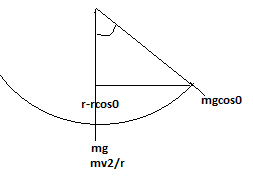72 - Newton's laws of motion and friction Questions Answers
![]() An open knife edge of mass m is dropped from a height h on a wooden floor. if the blade penetrates a dist s into the wood , the avg. resistance offered by wood to blade. ANS mg(1+h/s)
An open knife edge of mass m is dropped from a height h on a wooden floor. if the blade penetrates a dist s into the wood , the avg. resistance offered by wood to blade. ANS mg(1+h/s)
velocity at the time of strike of the knife at the wood = √(2gh)
now equation for penetration on the wood is R-mg = ma here R is reaction by the wood
so R = m(g+a)
here it is given that s is the distance penetrated by the knife on the wood so 02 = (√2gh) - 2as so a = 2gh/2s = gh/s
on taking this value of a
we get R = m(g+gh/s) = mg(1+h/s)
A LIFT IS MOVING UPWARD WITH ACC 2m/s2 .WHEN IT GAIN THE VELOCITY 4m/s THEN AT THAT MOMENT A BALL IS PROJECTED BY 300 (wrt floor to lift) WITH VEL. 4m/s RELATIVE TO LIFT . FIND HOW MUCH TIME WILL IT TAKE TO 1) TO REACH GROUND & 2) TO THE FLOOR OF LIFT AGAIN
since velocity of the ball is 4 m/s relative to lift so
time taken by the ball to reach the floor of lift T = 2usinθ/g = (2*4*1/2)/10 = 0.4 sec
height of the lift at the time of dropping the ball = (v2-u2)/2g = 16/20 = 8/10 = 0.8 m = h
and vertical component of the velocity of ball with respect to the ground = 6 m/s = u
so use -h = ut - gt2/2
a 1 kg block is attached (& held at rest with outside support) to free end of vertically hanging spring of force const. 10Ncm-1. when block is released wat max. extensn does it cause when it comes to rest instantaneously?
apply mgx = 1/2 kx2
for max. extension.
a block of mass m is suspended by a light thread from an elevator . the elevator starts moving up with a uniform acc . the work done during first t sec by tensn in thread ?
although i know how to calculate this ques . i.e w.d =Fds =m(g+a)Xds where ds=ut+1/2(at2) because acc is const a/c to ques BUT I want to know for ds why acc is a ,why not (a+g)
tension in the thread depends on g an a both.
but displacement covered by elevator depends only on the acceleration of the elevator, it does not depend upon the acceleration g thats why we do not use g in that case for finding displacement.
remember that in the problem we have to calculate work done by tension in the thread
two cars of masses m &M are moving in circles of radii r & R their speeds are such that they make complete circle in same time t. ratio of centripetal acceleration
1) m:M
2)R:r
3)1:1
4) MR:mr
aieee 2012 is the ans is (4)
since both make complete circle in same time t so angular velocities of the two will be same
now use F = mrω2
a cyclist is moving in a circle of radius 20m with velocity 5ms-1mass =60kg of both boy & cycle find static friction on tyre
v2/rg = µ
so µ = 5*5/20*10 = 1/8
Fs = µ * N = 1/8 * 60*10 = 600/8 = 75 N
µ is the coefficent of static friction, Fs is static friction and N is normal reaction
This answer is given by SHUBS and is correct answer
CENTRIPETAL & CENTRIFUGAL FORCES ALWAYS ACT IN PAIR. IS D STATEMENT IS CORRECT IF YES THEN Y &IF NOT THEN ALSO GIVE REASON
if you are observer in the ground then centripetal will work but if observer is in the rotating frame then centrifugal force will work. These two force does not form a pair
THE MAXm TENn IN STRING OF A SIMPLE PENDULUM IS 1.2TIMES THE MINm TENSION. IF a IS ANGULAR AMPLITUDE THEN a WILL BE
A)cos-1(4/5)
B)COS-1(3/4)
C)cos-1(15/16)
d) cos-1(7/8)
max tension at bottom point = mg+mv2/r
min tension at extreme point = mgcosθ
according to the given condition mg+mv2/r = 1.2mgcosθ (1)
and by energy conservation 1/2mv2 = mg(r-rcosθ) (2)
solve now answer will be C

Q E=ELECTROMAG F, G=GRAVT.F, N = NUCLEAR F B/W 2 e- AT A GIVEN PTN. THEN E>G>N HOW=? BECAUSE G< THEN OTHER FORCES.
for the distance upto fermi level order will be N>E>G
but the distance between electrons is greater than fermi level so the given order is justified because now nuclear forces will be very weak.
there is a small block of mass m kept at the left end of a larger block of mass M and length l.The system can slide on a horizontal road.The sysytem is started towards right with an initial velocity v. The friction coefficeient between the road and the bigger block is μ and that between the block is μ/2. Find the time elapsed before the smaller block separates from the bigger block?
Since there is no force for accelerating the larger block so larger block will be retarded due to this smaller block will move in forward direction
for the process equations are
0 + (µ/2)mg - µ(M+m)g = Ma (1)
(µ/2)mg - ma = ma1 (2)
take the value of a from eq (1) to eq (2) and get a1
then l = 0t + (1/2)a1 t2
